The AMD Radeon R9 290X Review
by Ryan Smith on October 24, 2013 12:01 AM EST- Posted in
- GPUs
- AMD
- Radeon
- Hawaii
- Radeon 200
Compute
Jumping into pure compute performance, we’re going to have several new factors influencing the 290X as compared to the 280X. On the front end 290X/Hawaii has those 8 ACEs versus 280X/Tahiti’s 2 ACEs, potentially allowing 290X to queue up a lot more work and to keep itself better fed as a result; though in practice we don’t expect most workloads to be able to put the additional ACEs to good use at the moment. Meanwhile on the back end 290X has that 11% memory bandwidth boost and the 33% increase in L2 cache, which in compute workloads can be largely dedicated to said computational work. On the other hand 290X takes a hit to its double precision floating point (FP64) rate versus 280X, so in double precision scenarios it’s certainly going to enter with a larger handicap.
As always we'll start with our DirectCompute game example, Civilization V, which uses DirectCompute to decompress textures on the fly. Civ V includes a sub-benchmark that exclusively tests the speed of their texture decompression algorithm by repeatedly decompressing the textures required for one of the game’s leader scenes. While DirectCompute is used in many games, this is one of the only games with a benchmark that can isolate the use of DirectCompute and its resulting performance.
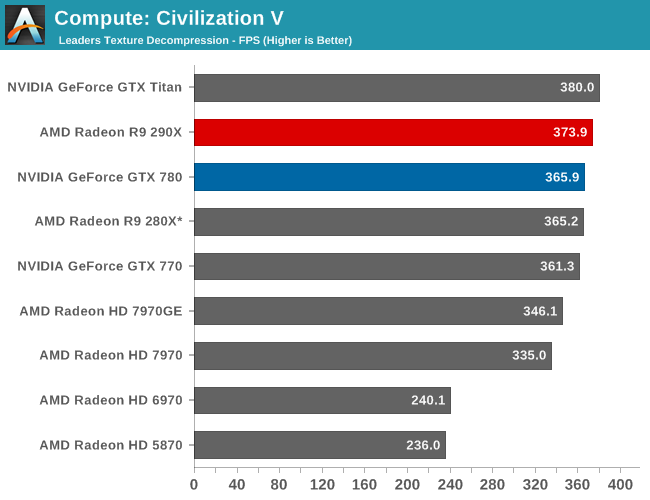
Unfortunately Civ V can’t tell us much of value, due to the fact that we’re running into CPU bottlenecks, not to mention increasingly absurd frame rates. In the 3 years since this game was released high-end CPUs are around 20% faster per core, whereas GPUs are easily 150% faster (if not more). As such the GPU portion of texture decoding has apparently started outpacing the CPU portion, though this is still an enlightening benchmark for anything less than a high-end video card.
For what it is worth, the 290X can edge out the GTX 780 here, only to fall to GTX Titan. But in these CPU limited scenarios the behavior at the very top can be increasingly inconsistent.
Our next benchmark is LuxMark2.0, the official benchmark of SmallLuxGPU 2.0. SmallLuxGPU is an OpenCL accelerated ray tracer that is part of the larger LuxRender suite. Ray tracing has become a stronghold for GPUs in recent years as ray tracing maps well to GPU pipelines, allowing artists to render scenes much more quickly than with CPUs alone.
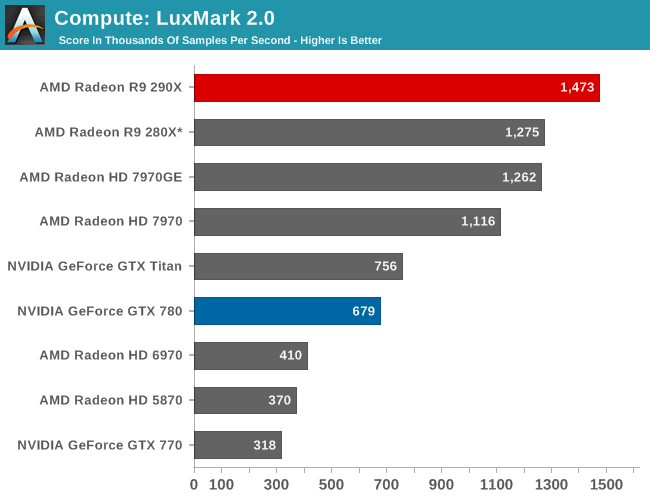
LuxMark by comparison is very simple and very scalable. 290X packs with it a significant increase in computational resources, so 290X picks up from where 280X left off and tops the chart for AMD once more. Titan is barely half as fast here, and GTX 780 falls back even further. Though the fact that scaling from the 280X to 290X is only 16% – a bit less than half of the increase in CUs – is surprising at first glance. Even with the relatively simplistic nature of the benchmark, it has shown signs in the past of craving memory bandwidth and certainly this seems to be one of those times. Feeding those CUs with new rays takes everything the 320GB/sec memory bus of the 290X can deliver, putting a cap on performance gains versus the 280X.
Our 3rd compute benchmark is Sony Vegas Pro 12, an OpenGL and OpenCL video editing and authoring package. Vegas can use GPUs in a few different ways, the primary uses being to accelerate the video effects and compositing process itself, and in the video encoding step. With video encoding being increasingly offloaded to dedicated DSPs these days we’re focusing on the editing and compositing process, rendering to a low CPU overhead format (XDCAM EX). This specific test comes from Sony, and measures how long it takes to render a video.
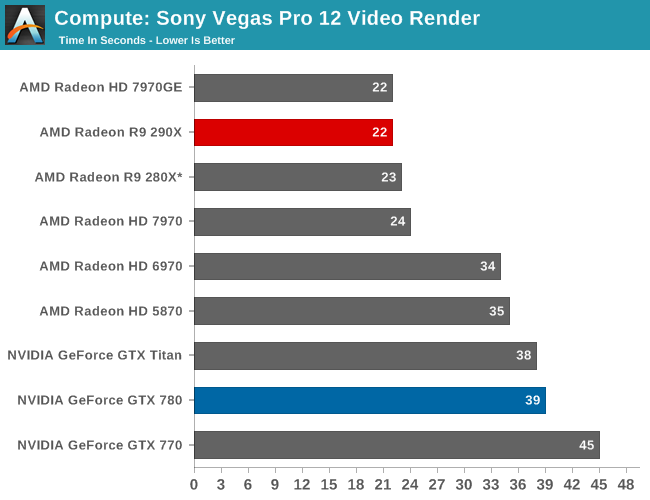
Vegas is another title where GPU performance gains are outpacing CPU performance gains, and as such earlier GPU offloading work has reached its limits and led to the program once again being CPU limited. It’s a shame GPUs have historically underdelivered on video encoding (as opposed to video rendering), as wringing significantly more out of Vegas will require getting rid of the next great CPU bottleneck.
Our 4th benchmark set comes from CLBenchmark 1.1. CLBenchmark contains a number of subtests; we’re focusing on the most practical of them, the computer vision test and the fluid simulation test. The former being a useful proxy for computer imaging tasks where systems are required to parse images and identify features (e.g. humans), while fluid simulations are common in professional graphics work and games alike.
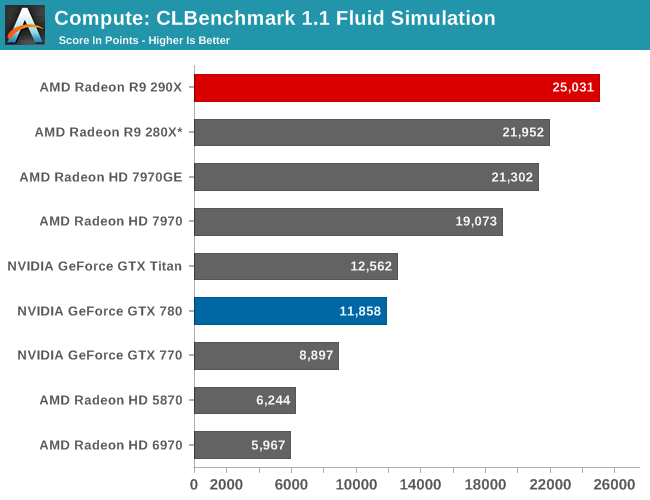
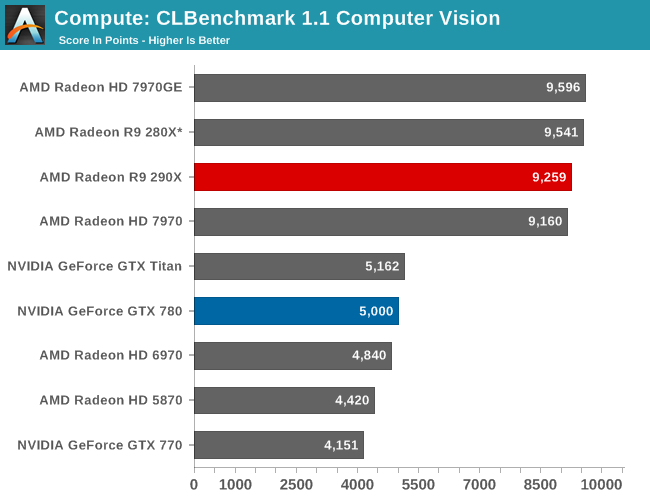
Curiously, the 290X’s performance advantage over 280X is unusual dependent on the specific sub-test. The fluid simulation scales decently enough with the additional CUs, but the computer vision benchmark is stuck in the mud as compared to the 280X. The fluid simulation is certainly closer than the vision benchmark towards being the type of stupidly parallel workload GPUs excel at, though that doesn’t fully explain the lack of scaling in computer vision. If nothing else it’s a good reminder of why professional compute workloads are typically profiled and optimized against specific target hardware, as it reduces these kinds of outcomes in complex, interconnected workloads.
Moving on, our 5th compute benchmark is FAHBench, the official Folding @ Home benchmark. Folding @ Home is the popular Stanford-backed research and distributed computing initiative that has work distributed to millions of volunteer computers over the internet, each of which is responsible for a tiny slice of a protein folding simulation. FAHBench can test both single precision and double precision floating point performance, with single precision being the most useful metric for most consumer cards due to their low double precision performance. Each precision has two modes, explicit and implicit, the difference being whether water atoms are included in the simulation, which adds quite a bit of work and overhead. This is another OpenCL test, as Folding @ Home has moved exclusively to OpenCL this year with FAHCore 17.
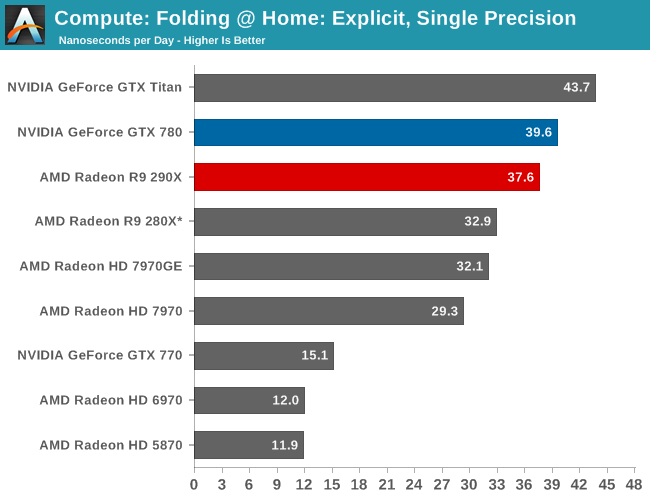
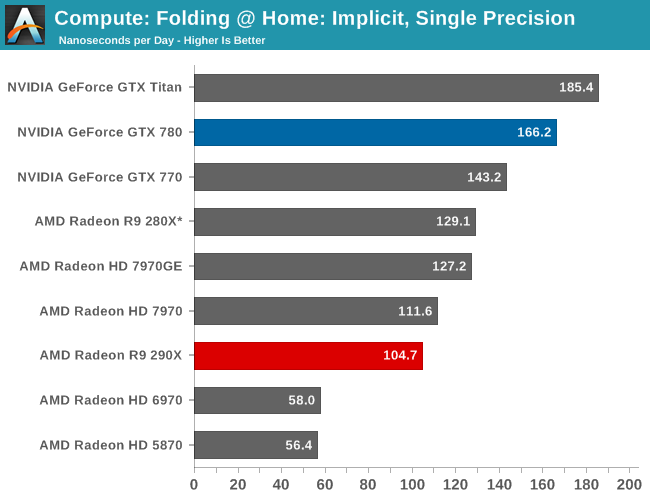

With FAHBench we’re not fully convinced that it knows how to best handle 290X/Hawaii as opposed to 280X/Tahiti. The scaling in single precision explicit is fairly good, but the performance regression in the water-free (and generally more GPU-limited) implicit simulation is unexpected. Consequently while the results are accurate for FAHCore 17, it’s hopefully something AMD and/or the FAH project can work out now that 290X has been released.
Meanwhile double precision performance also regresses, though here we have a good idea why. With DP performance on 290X being 1/8 FP32 as opposed to ¼ on 280X, this is a benchmark 290X can’t win. Though given the theoretical performance differences we should be expecting between the two video cards – 290X should have about 70% of the FP 64 performance of 280X – the fact that 290X is at 82% bodes well for AMD’s newest GPU. However there’s no getting around the fact that the 290X loses to GTX 780 here even though the GTX 780 is even more harshly capped, which given AMD’s traditional strength in OpenCL compute performance is going to be a let-down.
Wrapping things up, our final compute benchmark is an in-house project developed by our very own Dr. Ian Cutress. SystemCompute is our first C++ AMP benchmark, utilizing Microsoft’s simple C++ extensions to allow the easy use of GPU computing in C++ programs. SystemCompute in turn is a collection of benchmarks for several different fundamental compute algorithms, as described in this previous article, with the final score represented in points. DirectCompute is the compute backend for C++ AMP on Windows, so this forms our other DirectCompute test.
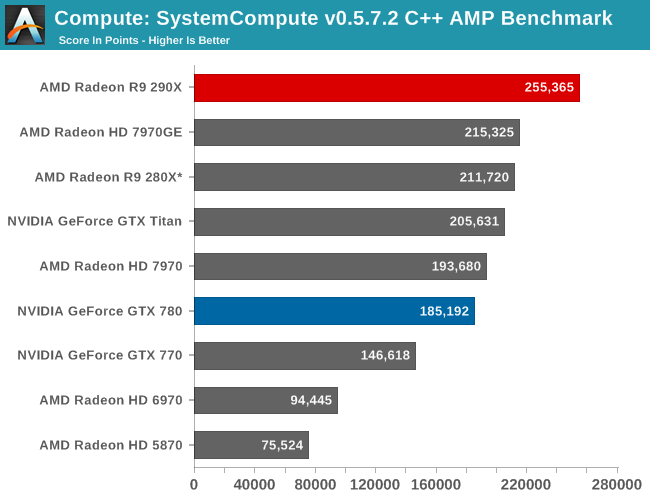
SystemCompute and the underlying C++ AMP environment scales relatively well with the additional CUs offered by 290X. Not only does the 290X easily surpass the GTX Titan and GTX 780 here, but it does so while also beating the 280X by 18%. Or to use AMD’s older GPUs as a point of comparison, we’re up to a 3.4x improvement over 5870, well above the improvement in CU density alone and another reminder of how AMD has really turned things around on the GPU compute side with GCN.










396 Comments
View All Comments
kyuu - Friday, October 25, 2013 - link
I agree. Ignore at all the complainers; it's great to have the benchmark data available without having to wait for all the rest of the article to be complete. Those who don't want anything at all until it's 100% done can always just come back later.AnotherGuy - Friday, October 25, 2013 - link
What a beastzodiacsoulmate - Friday, October 25, 2013 - link
Donno, all the geforce cards looks like sh!t in this review, and 280x/7970 290x looks like haven's god...but my 6990 7970 never really make me happier than my gtx 670 system...
well, whatever
TheJian - Friday, October 25, 2013 - link
While we have a great card here, it appears it doesn't always beat 780, and gets toppled consistently by Titan in OTHER games:http://www.techpowerup.com/reviews/AMD/R9_290X/24....
World of Warcraft (spanked again all resolutions by both 780/titan even at 5760x1080)
Splinter Cell Blacklist (smacked by 780 even, of course titan)
StarCraft 2 (by both 780/titan, even 5760x1080)
Titan adds more victories (780 also depending on res, remember 98.75% of us run 1920x1200 or less):
Skyrim (all res, titan victory at techpowerup) Ooops, 780 wins all res but 1600p also skyrim.
Assassins creed3, COD Black Ops2, Diablo3, FarCry3 (though uber ekes a victory at 1600p, reg gets beat handily in fc3, however hardocp shows 780 & titan winning apples-apples min & avg, techspot shows loss to 780/titan also in fc3)
Hardocp & guru3d both show Bioshock infinite, Crysis 3 (titan 10% faster all res) and BF3 winning on Titan. Hardocp also show in apples-apples Tombraider and MetroLL winning on titan.
http://www.guru3d.com/articles_pages/radeon_r9_290...
http://hardocp.com/article/2013/10/23/amd_radeon_r...
http://techreport.com/review/25509/amd-radeon-r9-2...
Guild wars 2 at techreport win for both 780/titan big also (both over 12%).
Also tweaktown shows lost planet 2 loss to the lowly 770, let alone 780/titan.
I guess there's a reason why most of these quite popular games are NOT tested here :)
So while it's a great card, again not overwhelming and quite the loser depending on what you play. In UBER mode as compared above I wouldn't even want the card (heat, noise, watts loser). Down it to regular and there are far more losses than I'm listing above to 780 and titan especially. Considering the overclocks from all sites, you are pretty much getting almost everything in uber mode (sites have hit 6-12% max for OCing, I think that means they'll be shipping uber as OC cards, not much more). So NV just needs to kick up 780TI which should knock out almost all 290x uber wins, and just make the wins they already have even worse, thus keeping $620-650 price. Also drop 780 to $500-550 (they do have great games now 3 AAA worth $100 or more on it).
Looking at 1080p here (a res 98.75% of us play at 1920x1200 or lower remember that), 780 does pretty well already even at anandtech. Most people playing above this have 2 cards or more. While you can jockey your settings around all day per game to play above 1920x1200, you won't be MAXING much stuff out at 1600p with any single card. It's just not going to happen until maybe 20nm (big maybe). Most of us don't have large monitors YET or 1600p+ and I'm guessing all new purchases will be looking at gsync monitors now anyway. Very few of us will fork over $550 and have the cash for a new 1440p/1600p monitor ALSO. So a good portion of us would buy this card and still be 1920x1200 or lower until we have another $550-700 for a good 1440/1600p monitor (and I say $550+ since I don't believe in these korean junk no-namers and the cheapest 1440p newegg itself sells is $550 acer). Do you have $1100 in your pocket? Making that kind of monitor investment right now I wait out Gsync no matter what. If they get it AMD compatible before 20nm maxwell hits, maybe AMD gets my money for a card. Otherwise Gsync wins hands down for NV for me. I have no interest in anything but a Gsync monitor at this point and a card that works with it.
Guru3D OC: 1075/6000
Hardwarecanucks OC: 1115/5684
Hardwareheaven OC: 1100/5500
PCPerspective OC: 1100/5000
TweakTown OC: 1065/5252
TechpowerUp OC: 1125/6300
Techspot OC: 1090/6400
Bit-tech OC: 1120/5600
Left off direct links to these sites regarding OCing but I'm sure you can all figure out how to get there (don't want post flagged as spam with too many links).
b3nzint - Friday, October 25, 2013 - link
"So NV just needs to kick up 780TI which should knock out almost all 290x uber wins, and just make the wins they already have even worse, thus keeping $620-650 price. Also drop 780 to $500-550"we're talking about titan killer here.
titan vs titan killer, at res 3840, at high or ultra :
coh2 - 30%
metro - 30%
bio - (10%) but win 3% at medium
bf3 - 15%
crysis 3 - tie
crysis - 10
totalwar - tie
hitman - 20%
grid 2 - 10%+
2816 sp, 64rop, 176tmu, 4gb 512bit. 780 or 780ti won't stand a chance. this is titan killer dude wake up. only then then we're talking CF, SLi and res 5760. But for single card i go for this titan killer. good luck with gsync, im not gave up my dell u2711 yet.
just4U - Friday, October 25, 2013 - link
Well.. you have to put this in context. Those guys gave it their editor's choice award and a overall score of 9.3 They summed it up with this.."
The real highlight of AMD's R9 290X is certainly the price. What has been rumored to cost around $700 (and got people excited at that price), will actually retail for $549! $549 is an amazing price for this card, making it the price/performance king in the high-end segment. NVIDIA's $1000 GTX Titan is completely irrelevant now, even the GTX 780 with its $625 price will be a tough sale."
theuglyman0war - Thursday, October 31, 2013 - link
the flagship gtx *80 $msrp has been $499 for every upgrade I have ever made. After waiting out the 104 fer the 110 chip only to have the insult of the previous 780 pricing meant I will be holding off to see if everything returns to normal with Maxwell. Kind of depressing when others are excited for $550? As far as I know the market still dictates pricing and my price iz $499 if AMD is offering up decent competition to keep the market healthy and respectful.ToTTenTranz - Friday, October 25, 2013 - link
How isn't this viral?nader21007 - Friday, October 25, 2013 - link
Radeon R9 290X received Tom’s Hardware’s Elite award—the first time a graphics card has received this honor. Nvidia: Why?Wiseman: Because it Outperformed a card that is nearly double it's price (your Titan).
Do you hear me Nvidia? Please don't gouge consumers again.
Viva AMD.
doggghouse - Friday, October 25, 2013 - link
I don't think the Titan was ever considered to be a gamer's card... it was more like "prosumer" card for compute. But it was also marketed to people who build EXTREME! machines for maximum OC scores. The 780 was basically the gamer's card... it has 90-95% of the Titan's gaming capability, but for only $650 (still expensive).If you want to compare the R9 290X to the Titan, I would look at the compute benchmarks. And in that, it seems to be an apples to oranges comparison... AMD and nVIDIA seem to trade blows depending on the type of compute.
Compared to the 780, the 290X pretty much beats it hands down in performance. If I hadn't already purchased a 780 last month ($595 yay), I would consider the 290X... though I'd definitely wait for 3rd party cards with better heat solutions. A stock card on "Uber" setting is simply way too hot, and too loud!